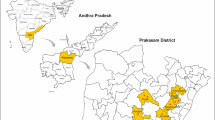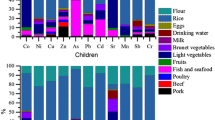Abstract
The study evaluated the health risk of metals in commonly consumed staple foods from Lagos and Ogun states, southwestern Nigeria. One hundred and thirty-three food samples were collected and analyzed for Zn, Cr, Cd, Ni, and Pb using atomic absorption spectrophotometric method. Data collected were analyzed for simple descriptive and inferential statistics using SPSS for Windows. The health risk of metals in staple foods was assessed for average daily dose (ADD), hazard quotient (HQ), hazard index (HI), and cancer risk (CR). Results showed the highest concentrations of Zn (18.99 ± 13.62 mg kg−1) and Ni (0.21 ± 0.10 mg kg−1) in beans, while the highest amount of Cr (2.04 ± 1.44 mg kg−1) was obtained in rice. Cd concentrations in staple foodstuffs ranged from < 0.01 to 0.30 mg kg−1, while Pb was below the detection limit. The average levels of Zn in beans and maize were higher than the recommended dietary allowance (9.5 mg kg−1) of the Institute of Medicine. The mean concentrations of Cr and Cd (except for rice) in staple food samples were also higher than the permissible standards. The health risk data revealed HQ value greater than 1.0 for Cr in the food samples, indicating non-carcinogenic adverse health effects. The HI value greater than 1.0 in staple foods established cumulative adverse effects of metals. The carcinogenic evaluation of Cr (in all the food samples) and Ni (in beans) showed CR values greater than the acceptable limit of 1.0 × 10−4, thereby demonstrating possible development of cancer through consumption of the staple foodstuffs.



Similar content being viewed by others
References
Addo, M. A., Darko, E. O., Gordon, C., & Nyarko, B. J. B. (2013). Heavy metal contaminations in soil and cassava harvested near a cement processing facility in the Volta Region, Ghana: implications of health risk for the population living in the vicinity. e-Journal of Science and Technology, 8(3), 71–83.
Ali, M. H., & Al-Qahtani, K. M. (2012). Assessment of some heavy metals in vegetables, cereals and fruits in Saudi Arabian markets. The Egyptian Journal of Aquatic Research, 38(1), 31–37.
AOAC (Ed.). (2000). Official methods of analysis (20th ed.). USA: AOAC International, Gaithersburg, MD.
ATSDR. (2005). Cadmium toxicity: where is cadmium found? https://www.atsdr.cdc.gov/phs/phs.asp?id =300&tid=54. Accessed: 25/01/2019.
ATSDR. (2008). Public Health Statement for zinc. https://www.atsdr.cdc.gov/csem/csem.csem=6&po=5. Accessed: 08/04/2018.
Ayedun, H., Gbadebo, A. M., Idowu, O. A., & Arowolo, T. A. (2015). Toxic elements in groundwater of Lagos and Ogun States, Southwest, Nigeria and their human health risk assessment. Environmental Monitoring and Assessment, 187(6), 1–17.
Bhatia, A., Singh, S., & Kumar, A. (2015). Heavy metal contamination of soil, irrigation water and vegetables in peri-urban agricultural areas and Markets of Delhi. Water Environment Research, 87(11), 2027–2034.
Braimoh, A. K., & Onishi, T. (2007). Spatial determinants of urban land use change in Lagos, Nigeria. Land Use Policy, 24(2), 502–515.
Dibofori-Orji, A. N., & Edori, O. S. (2015). Analysis of some heavy metals (Pb, Cd, Cr, Fe, Zn) in processed cassava flour (garri) sold along the road side of a busy highway. Archive of Applied Science and Research, 7(2), 15–19.
Fan, Y., Zhu, T., Li, M., He, J., & Huang, R. (2017). Heavy metal contamination in soil and Brown Rice and human health risk assessment near three mining areas in Central China. Journal of Healthcare Engineering, 2017, 1–9. https://doi.org/10.1155/2017/4124302.
FAO. (2008). The state of world fisheries and aquaculture (2008). Rome: FAO Fisheries and Aquaculture Department. Food and Agriculture Organization of the UN.
FAO/WHO. (2015). General standard for contaminants and toxins in food and feed (CODEX STAN 193-1995). Working document for information and use in discussions related to contaminants and toxins in the GSCTFF. Codex Alimentarius Commission international food standards. www.fao.org/input/download/standards/17/CXS _193e_2015.pdf. Accessed: 03/03/2018.
Figueroa, D. A., Rodríguez-Sierra, C. J., & Jiménez-Velez, B. D. (2006). Concentrations of Ni and V, other heavy metals, arsenic, elemental and organic carbon in atmospheric fine particles (PM2. 5) from Puerto Rico. Toxicology and Industrial Health, 22(2), 87–99.
Finelib.com. (2017). Beans producing states in Nigeria and its various types. https://www.finelib.com/about/nigeria-cash-crops/beans-producing-states-in-nigeria-and-its-various-types/112. Accessed: 01/03/2018.
Gnonlonfin, G. B., Sanni, A., & Brimer, L. (2012). Preservation of cassava (Manihot esculenta Crantz): a major crop to nourish people worldwide. Progress in Food Preservation, 224131, 331.
Hanaa, M., Eweida, A., & Farag, A. (2000). Heavy metals in drinking water and their environmental impact on human health. In International Conference on Environmental Hazards Mitigation, Cairo University, Egypt (pp. 542–556).
Huang, Z., Pan, X.-D., Wu, P.-G., Han, J.-L., & Chen, Q. (2013). Health risk assessment of heavy metals in rice to the population in Zhejiang, China. PLoS One, 8(9), e75007. https://doi.org/10.1371/journal.pone.0075007.
IOM (Institute of Medicine). (2001). Dietary reference intakes for vitamin A, vitamin K, arsenic, boron, chromium, copper, iodine, iron, manganese, molybdenum, nickel, silicon, vanadium, and zinc (pp. 442–501). Washington, DC: National Academy Press.
Iweala, E. E. J., Olugbuyiro, J. A. O., Durodola, B. M., Fubara-Manuel, D. R., & Okoli, A. O. (2014). Metal contamination of foods and drinks consumed in Ota, Nigeria. Research and Environmental Toxicology, 8(2), 92–97.
Iyaka, Y. A. (2011). Nickel in soils: a review of its distribution and impacts. Scientific Research Essay, 6(33), 6774–6777.
Jarup, L. (2003). Hazards of heavy metal contamination. British Medical Bulletin, 68(1), 167–182.
Jedy-Agba, E., Curado, M. P., Ogunbiyi, O., Oga, E., Fabowale, T., Igbinoba, F., & Adebamowo, C. A. (2012). Cancer incidence in Nigeria: a report from population-based cancer registries. Cancer Epidemiology, 36, e271–e278.
Jones, R. E. (1990). Hexavalent chrome: threshold concept for carcinogenicity. Biomedical and Environmental Sciences, 3(1), 20–34.
Lenntech. (2018). Heavy metals. https://www.lenntech.com/processes/heavy/heavy-metals/heavy-metals.htm. Accessed: 06/03/2018.
National Population Commission. (2010). 2006 Population and Housing Census. Federal Republic of Nigeria. Priority Table Volume III. 64p. https://catalog.ihsn.org/index.php/catalog/3340/download/48521. Accessed: 06/02/2019.
Nriagu, J. (2007). Zinc toxicity in humans. School of Public Health , University of Michigan. 1-7p.http://extranet.elsevier.com/homepage_about/mrwd/nvrn/Zinc%20Toxicity%20in%20Humans.pdf.Accessed: 06/02/2019.
Okereke, C. J., Essien, E. B., & Wegwu, M. O. (2016). Human health risk assessment of heavy metal contamination for population via consumption of selected vegetables and tubers grown in farmlands in Rivers State, South-South Nigeria. Journal of Analytical Pharmaceutical Research, 3(6), 00077. https://doi.org/10.15406/japlr.2016.03.00077.
Oladejo, N. A., Anegbe, B., & Adeniyi, O. (2017). Accumulation of heavy metals in soil and maize plant (Zea mays) in the vicinity of two government approved dumpsites in Benin City, Nigeria. Asian Journal of Chemical Sciences, 2456-7795, 3(3), 1–9.
Olatunji, O., & Ayuba S. A. (2012). Effect of combined applications of poultry manure and NPK 20–10-10 fertilizer on soil chemical properties and yield of maize (Zea mays L.). Proceedings of the 35th Annual Conference of the Soil Science Society of Nigeria (SSSN). 7th – 11th March, 2011, Federal University of Technology Minna.
Olu, M., Olufade, O. I., Adekoyeni, O. O., & Jimoh, M. O. (2013). Evaluation of heavy metal concentration in maize grown in selected industrial areas of Ogun State and its effects on Urban Food Security. International Journal of Science, Technology and Society, 1(2), 48–56.
Orisakwe, O. E., Nduka, J. K., Amadi, C. N., Dike, D. O., & Bede, O. (2012). Heavy metals health risk assessment for population via consumption of food crops and fruits in Owerri, South Eastern, Nigeria. Chemical Central Journal, 6(1), 77. https://doi.org/10.1186/1752-153X-6-77.
Prashanth, L., Kattapagari, K. K., Chitturi, R. T., Baddam, V. R. R., & Prasad, L. K. (2015). A review on role of essential trace elements in health and disease. Journal of Dr. Ntr University of Health Sciences, 4(2), 75.
Rousseau, M. C., Straif, K., & Siemiatycki, J. (2005). IARC carcinogen update. Environment Health Perspective, 113(9), A580–A581.
Saikia, R., Bezbaruah, R., & Bora, T. C. (2008). Microbial biotechnology. Pitam Pura: New India Publishing Agency 424p.
Saulick, B., Bhoyroo, V., Nazurally, N., & Lalljee, B. (2017). Heavy metal bioaccumulation in commercial Lethrinidae fish species in Mauritius. Italian Journal of Food Safety, 6(4), 6607.
Taiwo, A. M., & Awomeso, J. A. (2017). Assessment of trace metal concentration and health risk of artisanal gold mining activities in Ijeshaland, Osun State Nigeria—Part 1. Journal of Geochemical Exploration, 177, 1–10.
Taiwo, A. M., Beddows, D. C., Shi, Z., & Harrison, R. M. (2014). Mass and number size distributions of particulate matter components: comparison of an industrial site and an urban background site. Science of theTotal Environment, 475, 29–38.
Taiwo, A. M., Awomeso, J. A., Taiwo, O. T., Oremodu, B. D., Akintunde, O. O., Ojo, N. O., Elegbede, O. O., Olanrewaju, H. H., & Arowolo, T. A. (2017). Assessment of health risks associated with road dusts in major traffic hotspots in Abeokuta metropolis, Ogun state, southwestern Nigeria. Stochastic Environment Research Risk Assessment, 31(2), 431–447.
Taiwo, A. M., Oyebode, A. O., Salami, F. O., Okewole, I., Gbogboade, A. S., Agim, C., Oladele, T. O., Kamoru, T. A., Abdullahi, K. L., & Davidson, N. (2018). Carcinogenic and non-carcinogenic evaluations of heavy metals in protein foods from southwestern Nigeria. Journal of Food Analysis Composition, 73, 60–66.
USEPA (United States Environmental Protection Agency). (2002). Integrated risk information system (IRIS) database. Washington DC: National Center for Environmental Assessment.
USEPA (United States Environmental Protection Agency). (2007). Framework for metal risk assessment (EPA 120-R-07-001 Washington DC). USEPA (United States Environmental Protection Agency). (2012). Edition of the drinking water standards and health advisories (EPA 822-S12–001).
Usman, M., Madu, V. U., & Alkali, G. (2015). The combined use of organic and inorganic fertilizers for improving maize crop productivity in Nigeria. International Journal of Science and Research Publications, 5, 1–7.
Uwaegute, A. C., Osho, S. M., & Obatolu, V. A. (1995). Acceptability and chemical evaluation of fortified Yam (Dicscorea spp) products. Postharvest Technology and Commodity Marketing. Edited by RSB Ferris. International Institute of Tropical Agriculture, Ibadan, Nigeria. Proceedings of a postharvest conference 2 Nov. to 1 Dec. 1995. Accra, Ghana: 172.
WHO. (2014). Cancer country profiles 2014 http://www.who.int/cancer/country-profiles/nga_en.pdf. Accessed: 10/07/18).
WHO. (2015). Country statistics, Nigeria. www.who.int/country/nga/en. (Accessed:10/07/17).
Acknowledgements
The authors acknowledge the laboratory assistance from the Central Laboratory, University of Ibadan, during the sample analyses.
Author information
Authors and Affiliations
Corresponding author
Ethics declarations
Conflicts of interest
The authors declare that they have no conflict of interest.
Additional information
Publisher’s note
Springer Nature remains neutral with regard to jurisdictional claims in published maps and institutional affiliations.
Electronic supplementary material
ESM 1
(DOCX 29 kb)
Rights and permissions
About this article
Cite this article
Taiwo, A.M., Oyeleye, O.F., Majekodunmi, B.J. et al. Evaluating the health risk of metals (Zn, Cr, Cd, Ni, Pb) in staple foods from Lagos and Ogun States, Southwestern Nigeria. Environ Monit Assess 191, 167 (2019). https://doi.org/10.1007/s10661-019-7307-5
Received:
Accepted:
Published:
DOI: https://doi.org/10.1007/s10661-019-7307-5




